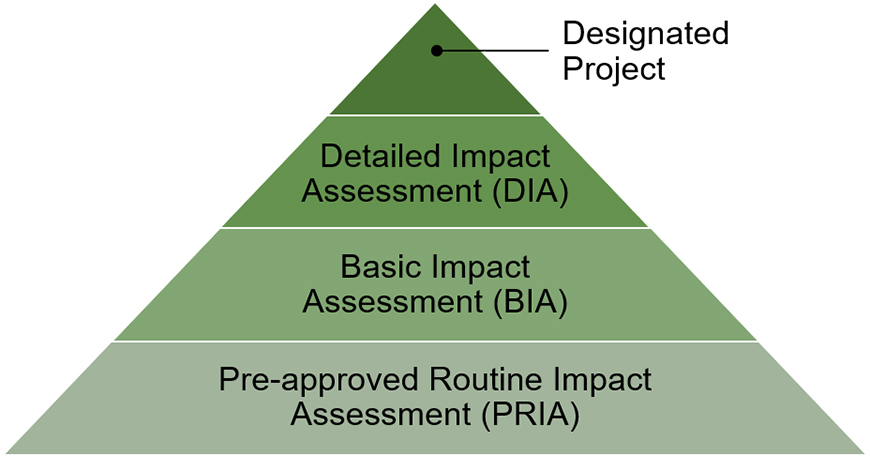
Project-level assessment
The impact assessment process works a bit differently according to where it takes place in the country. Different regulatory regimes may apply to a project depending on the province or territory in which it is proposed.
South of the 60th parallel
In provinces south of the 60th parallel, the legal requirements for impact assessment are outlined in the Impact Assessment Act, 2019. The Act requires all federal authorities like Parks Canada to determine prior to project approval that “the carrying out of the project is not likely to cause significant adverse environmental effects.” The Act does not prescribe the process used to make this determination. Parks Canada has developed its own Impact Assessment Process to fulfil the requirement. The Parks Canada process is designed to ensure that assessments are effective, efficient and sensible.
Pathways of project-level impact assessment
Transcript
A wide variety of projects occur on land administered by Parks Canada.
We want to make sure that the impact assessment process for the project will be best at identifying the mitigation needed and that we focus our energy on projects that have the greatest risk to the environment.
Parks Canada has a robust framework in place to assess the impact of project proposals on national parks, national marine conservation areas and national historic sites.
There are four different types of assessment processes.
Preapproved routine impact assessments are used for simple, predictable projects. They prescribe a suite of tried and true environmental mitigation measures. For example, preapproved routine impact assessment is used for the installation of prefabricated structures, such as interpretive displays and sheds.
You can review preapproved routine impact assessments on the Parks Canada internet site. Basic impact assessments are for routine projects with impacts limited to the area of the project. For example, a new short trail.
You can find projects being assessed with basic impact assessments on the Impact Assessment Registry of Canada by looking for projects proposed by Parks Canada.You can also find detailed impact assessments on this registry.
Detailed impact assessments are for complex projects. These require a more in-depth analysis and there are more opportunities for the public to participate.
Finally, we occasionally examine a designated project in a place administered by Parks Canada. Assessments of designated projects, which are listed on a regulation, are led by the Impact Assessment Agency of Canada.
We invite you to learn more by visiting pc.gc.ca.
Graphic representation of the four types of impact assessment pathways employed by Parks Canada for project-level assessments. The top of the pyramid represents the Designated Project pathway; the second level represents the Detailed Impact Assessment (DIA) pathway, the third level represents the Basic Impact Assessment (BIA) pathway, and the bottom level represents the Pre-approved Routine Impact Assesment (PRIA) pathway.

Long Description:
The first step in the process is Parks Canada assigns the project to one of three pathways. The pathway assignment reflects the project’s potential risks to the environment. It also accounts for the certainty about those risks and the ease of risk mitigation. Public interest in the project is also considered.
There is some flexibility in the pathway assignment. This ensures that the process responds to specific circumstances.
Preapproved routine impact assessment (PRIA): Parks Canada developed a set of preapproved assessments for classes of routine projects. This pathway is assigned when the project belongs to one of those classes. The project effects are well understood and predictable. The PRIA prescribes a suite of tried and true environmental management and mitigation measures.
For example, PRIAs have been developed for the installation of prefabricated structures, such as picnic tables or interpretive displays. To view the PRIAs, visit Pre-approved Routine Impact Assessments on Open Government.
Basic impact assessment (BIA): This pathway is applied when potential adverse environmental effects are predictable and will be confined to the project site or immediate surroundings. Some site-specific strategies may be needed to prevent environmental effects.
BIAs may be conducted for short hiking trails through sensitive environments.
Detailed impact assessment (DIA): This pathway is applied to complex projects. They require in-depth analysis of project interactions with the environment. The project may threaten a sensitive environmental setting, species or feature. The scope of work may attract lots of interest from Indigenous groups, the public and stakeholders. This pathway provides more in-depth consultation opportunities.
For example, a DIA could be conducted for construction of a new visitor centre. To learn more about the DIA pathway, consult the detailed impact assessment process at Parks Canada brochure. (PDF, 1.11 MB)
For more information on project-level assessments, see the Guide to the Parks Canada Process under the Impact Assessment Act.
Transcript
Parks Canada has a robust framework in place to assess the impact of project proposals on national parks, marine conservation areas and historic sites.
Detailed impact assessments (or DIAs) are the most in-depth impact assessments conducted by Parks Canada. By understanding the DIA process, you will be better able to participate. Detailed impact assessments are for complex projects. These require a more in-depth analysis and there are more opportunities for the public to participate.
For example, when an invasive species threatened the hemlock trees of Kejimikujik national park and national historic site, we did a DIA of the proposed active management. Each project is reviewed to ensure it is consistent with policy and legislation. Then a process is developed which fits with the situation. In particular, we work with Indigenous people to understand how they want to be involved as we design the process.
All DIAs are based on the best available evidence including western science, such as monitoring and research results and Indigenous knowledge reflecting Indigenous use and culture. Together, both forms of evidence contribute to high confidence determinations based on the defensible, transparent analysis. All DIAs also consider alternatives, impacts to natural and cultural resources, mitigation, cumulative effects, follow-up monitoring that will happen after the project is constructed and public participation.
Your participation is invited through the Canadian Impact Assessment Registry and, usually, other opportunities as well. We want to hear from you about which aspects of the environment, cultural history or other impacts you are most concerned about. We also seek your ideas about how they can be protected while carrying out the project. You are also encouraged to review the DIA document and provide us with more detailed comments.
To learn more visit pc.gc.ca.
Designated projects
The Parks Canada impact assessment process is not applied to Designated Projects, which are listed on the Physical Activities Regulations. If a project falls within the classes listed in the Regulations, it is assessed by the Impact Assessment Agency of Canada. The Agency follows the process identified in the Impact Assessment Act, 2019.
- Date modified :